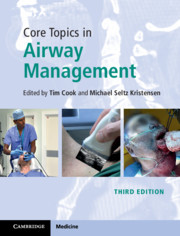Book contents
- Core Topics in Airway Management
- Core Topics in Airway Management
- Copyright page
- Contents
- Contributors
- Foreword
- Preface to the Third Edition
- Section 1 Airway Management: Background and Techniques
- Chapter 1 Anatomy
- Chapter 2 Physiology of Apnoea, Hypoxia and Airway Reflexes
- Chapter 3 The Epidemiology of Airway Management Complications
- Chapter 4 Structured Planning of Airway Management
- Chapter 5 Pre-anaesthetic Airway Assessment
- Chapter 6 Pre-anaesthetic Airway Endoscopy, Real and Virtual
- Chapter 7 Ultrasonography for Airway Management
- Chapter 8 Oxygenation: before, during and after Airway Management
- Chapter 9 Awake Tracheal Intubation
- Chapter 10 Drugs for Airway Management
- Chapter 11 How to Avoid Morbidity from Aspiration of Gastric Content to the Lungs
- Chapter 12 Face Mask Ventilation
- Chapter 13 Supraglottic Airways
- Chapter 14 Tracheal Intubation: Direct Laryngoscopy
- Chapter 15 Tracheal Tube Introducers (Bougies), Stylets and Airway Exchange Catheters
- Chapter 16 Tracheal Intubation Using the Flexible Optical Bronchoscope
- Chapter 17 Videolaryngoscopy
- Chapter 18 Expiratory Ventilation Assistance and Ventilation through Narrow Tubes
- Chapter 19 Multimodal Techniques for Airway Management
- Chapter 20 Front of Neck Airway (FONA)
- Chapter 21 Extubation
- Section 2 Airway Management: Clinical Settings and Subspecialties
- Section 3 Airway Management: Organisation
- Index
- References
Chapter 13 - Supraglottic Airways
from Section 1 - Airway Management: Background and Techniques
Published online by Cambridge University Press: 03 October 2020
- Core Topics in Airway Management
- Core Topics in Airway Management
- Copyright page
- Contents
- Contributors
- Foreword
- Preface to the Third Edition
- Section 1 Airway Management: Background and Techniques
- Chapter 1 Anatomy
- Chapter 2 Physiology of Apnoea, Hypoxia and Airway Reflexes
- Chapter 3 The Epidemiology of Airway Management Complications
- Chapter 4 Structured Planning of Airway Management
- Chapter 5 Pre-anaesthetic Airway Assessment
- Chapter 6 Pre-anaesthetic Airway Endoscopy, Real and Virtual
- Chapter 7 Ultrasonography for Airway Management
- Chapter 8 Oxygenation: before, during and after Airway Management
- Chapter 9 Awake Tracheal Intubation
- Chapter 10 Drugs for Airway Management
- Chapter 11 How to Avoid Morbidity from Aspiration of Gastric Content to the Lungs
- Chapter 12 Face Mask Ventilation
- Chapter 13 Supraglottic Airways
- Chapter 14 Tracheal Intubation: Direct Laryngoscopy
- Chapter 15 Tracheal Tube Introducers (Bougies), Stylets and Airway Exchange Catheters
- Chapter 16 Tracheal Intubation Using the Flexible Optical Bronchoscope
- Chapter 17 Videolaryngoscopy
- Chapter 18 Expiratory Ventilation Assistance and Ventilation through Narrow Tubes
- Chapter 19 Multimodal Techniques for Airway Management
- Chapter 20 Front of Neck Airway (FONA)
- Chapter 21 Extubation
- Section 2 Airway Management: Clinical Settings and Subspecialties
- Section 3 Airway Management: Organisation
- Index
- References
Summary
Supraglottic airways (SGAs) have been part of core anaesthetic practice for approximately 30 years, since the introduction of the classic laryngeal mask which is described in some detail. In many countries an SGA is now used for airway management for the majority of anaesthetics. Optimal use and insertion technique are described. The range of SGAs available and their roles have expanded dramatically in this time. Second generation SGAs are those designed to reduce the risk of aspiration and are emphasised in this chapter. With the wide range of SGAs available it can be problematic to decide which device to use and this is especially so as the boundaries of acceptable use are ever widened. This chapter describes those devices with the greatest versatility and utility – arguably also with the greatest safety profile too – and some newer devices. SGAs have a major role to play in advanced and difficult airway management. The use of an SGA as a rescue device and as a conduit for intubation during management of the difficult airway is described in detail.
Keywords
- Type
- Chapter
- Information
- Core Topics in Airway Management , pp. 102 - 121Publisher: Cambridge University PressPrint publication year: 2020

